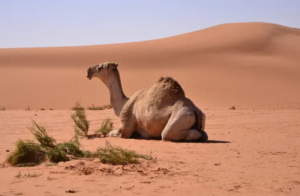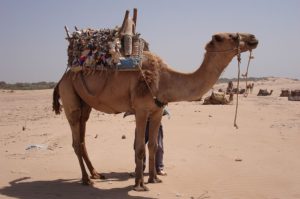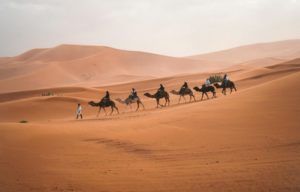CAMELS have long fascinated people around the world, especially in cultures where communities depend on camels for trade, transport and livelihoods. Found mostly in desert regions such as Rajasthan and the Middle East, camels are also known to live in the freezing cold temperatures of Central Asia as well. The camel is treasured in cultures around the world which have seen humans develop a close and deep bond with the animal. In fact, it is said that there are at least 100 words for camel in the Arabic language for camel.
Camels were domesticated by man more than 3,000 years ago and it is largely thought that the camel originated on the North American continent during the Cenozoic Era and traveled across the world. Now mostly suited to desert climates, these mammals are enchanting, emotional and resilient creatures.
Here are 5 amazing facts about camels!
Camels can survive for weeks without water
Camels are famous for being able to survive for weeks without water and for months without food. Their main habitat is in desert regions where plants and water are scarce, so their bodies have adapted to coping without water for long periods of time. It has been found in a study by The University of Bristol that thousands of genes changed in the kidney of a one-humped camel as a consequence of dehydration and rehydration, allowing the mammal to avoid water loss. These remarkable evolutionary abilities allow the camel to drink large amounts of water and withstand a loss of water up to 30% of their body weight.

Camels store rich fat in their humps
Camels are classified by the number of humps on their backs. The one-humped camel is a Dromedary camel while the two-humped camel is called a Bactrian camel. Found within a camel’s humps are rich fat deposits, which is their primary energy source. Since these animals are mostly found in dry and arid places, it is difficult for them to find food sources, which usually consist of grass, grains, wheat and oats. When camels eat, they can store up to 36 kg of fat in their humps and their bodies can later convert this stored fat into energy when the animals need some nourishment during a time of food scarcity.

Camels are called the ships of the desert
When humans first domesticated the camel, it was for the purpose of traveling and carrying goods and people across vast stretches of land. A camel can weigh anywhere from 400 kg to 600 kg and can carry up to 200 kg on their backs. This makes them the ideal animal for transportation purposes especially when the terrain is often dry and arid, making it difficult for other animals or even vehicles to navigate. Camels are called “the ships of the desert” due to their ability to travel across long distances within the desert, an ability made possible by their physical characteristics suited for travel in desert terrain and ability to remember routes.

Camels have close social structures
Camels, just like all other mammals, travel in groups called herds. Camels are social creatures and often greet one another by blowing in each other’s faces. Herds are usually headed by a dominant male and when other males are not included in the herd, they are known to form their own herd. When a female camel is pregnant, the gestation period is around 12 to 14 months. If you have watched camels walking in the desert, or caught a glimpse of it in movies like Aladdin or The Mummy, you will notice that they walk in single file. This is a part of their social structure in which the male walks toward the back to protect the females and the young.

Camels’ bodies are suited to desert survival
Camels’ bodies are naturally suited to their desert habitat. In addition to the humps on their backs, camels can close their nostrils when there are harsh sandstorms. Still on the topic of camel noses, the air that a camel exhales is cooled since the water vapor is removed and it remains in the body. To keep the sand out of their eyes, camels have long eyelashes and a third set of eyelids. Furthermore a camel’s feet, knees, elbows and breastbone have natural thick padding, allowing them to sit on the hot sand. These mammals can live in both extreme hot and cold temperatures and sweat when the temperature reaches 41°C (106°F).

But camels are abused and need your support
Despite their unique characteristics and close bonds with their herds, camels are often treated in a cruel manner and misused for labor and entertainment – abusing and torturing them beyond what their bodies can handle. Camels are forced to carry loads that often end up breaking their feet and legs and even injuring their necks. The beatings and burns they endure at the hands of their handlers leave them with deep wounds that lead to permanent damage and even death.
India Animal Foundation and Help In Suffering cares for abused camels by administering medical treatment to wounded camels aided by a camel ambulance that allows them to reach animals in desperate need of urgent medical care. For others who are too old or too wounded to be of any use to their handlers, Help In Suffering takes them to their camel sanctuary where they have enough space to roam around on the green grass and have sufficient food and medicine each day to keep them alive and well. Watch this campaign video by Help In Suffering to find out how your support can help these abused and mistreated animals:
To find out how you can rescue abused camels and give them shelter and care, join the mission by India Animal Foundation and Help In Suffering:
Save camels from abuse and torture
–
Give’s mission is to “make giving bigger and better.” Give is the most trusted donation platform in India for fundraisers and crowdfunding campaigns. Through our technology solutions, we enable individuals and organisations to fundraise and donate to a cause, charity or NGO with trust and convenience. Give’s community of 2.7M+ individual donors and 300+ organisations supports 3,000+ verified nonprofits with 80G deduction and serves 15M+ people across India. Find a fundraiser today!

Shirley has been in the development sector for over 10 years and is passionate about making a change in the world around her, including adopting dogs and writing to make a difference.
Discover more from
Subscribe to get the latest posts sent to your email.

